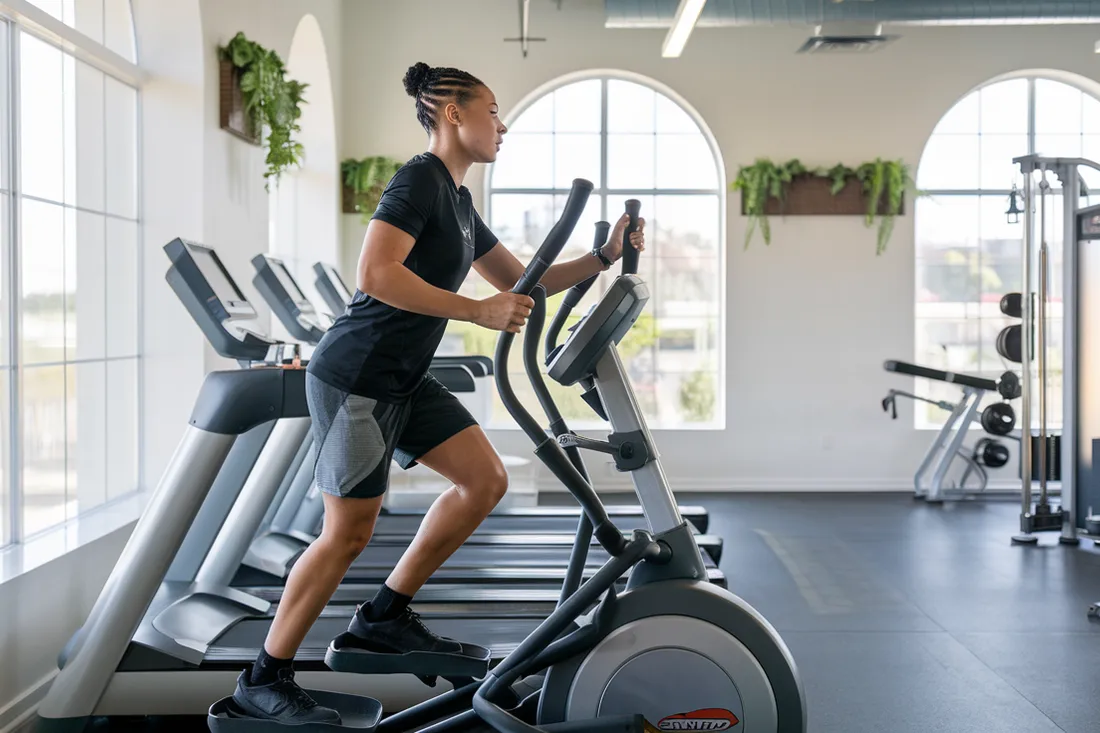Are you tired of feeling stuck in a rut, struggling to find the motivation to start a new fitness routine?
According to the National Institutes of Health (NIH), 70% or higher of Americans are not meeting their physical activity guidelines, leading to a range of health issues, from obesity and diabetes to depression and anxiety. (1)
Despite the numerous benefits of exercise, many people struggle to establish a consistent routine.

For beginners, elliptical workouts can be a great way to get started, offering a low-impact, full-body exercise experience that’s easy to incorporate into a daily routine.
Elliptical workouts have been shown to burn calories, improve cardiovascular health, and boost muscle strength and endurance – all while reducing the risk of injury.
The truth is, starting a fitness routine can be overwhelming for beginners.
Where do you start?
What exercises should you do?
How do you even set up your workout routine?
We will take you on a 7-day journey to get started with elliptical workouts.
We’ll cover the basics of choosing the right machine, setting up your workout routine, and overcoming common obstacles.
By the end of this challenge, you’ll be equipped with the knowledge and confidence to maintain a consistent fitness routine and achieve your health goals.
Getting Started with Elliptical Workouts

Choosing the Right Elliptical Machine for Beginners
When it comes to getting started with elliptical workouts, the first step is to choose the right machine.
As a beginner, you’ll want to look for an elliptical machine that’s easy to use, comfortable, and has features that cater to your needs.
Here are some tips to consider:
- Look for an elliptical machine with a comfortable stride length and handlebars that allow you to adjust your grip.
- Consider a machine with pre-set programs and customizable settings to keep your workouts interesting and challenging.
- Check if the machine has a weighted flywheel or a quiet drive system for a smoother ride.
- Read reviews and talk to friends who have used elliptical machines to get recommendations.
Setting Up the Machine and Adjusting the Settings
Once you’ve chosen the right elliptical machine, it’s time to set it up and adjust the settings.
Here are some tips to get you started:
- Adjust the stride length to fit your body comfortably.
- Set the resistance level to a moderate level (around 5-6) for beginners.
- Adjust the handlebars to a comfortable height and position.
- Check the display screen to make sure it’s easy to read and understand.
Warming Up and Cooling Down Exercises
Before you start your elliptical workout, it’s essential to warm up and cool down properly.
Here are some exercises you can do:
- Warm-up: 5-10 minutes of light cardio such as jogging in place or jumping jacks.
- Cool-down: 5-10 minutes of stretching exercises, focusing on your legs, hips, and back.
Additional Tips for Beginners
- Start with short sessions (20-30 minutes) and gradually increase the duration as you get more comfortable.
- Listen to your body and take breaks when needed.
- Focus on proper form and technique to avoid injury.
By following these tips, you’ll be well on your way to getting started with elliptical workouts and achieving your fitness goals.
Day 1-7 Workout Routines
Day 1: Warm-Up and Basic Workout
- Warm-up: 5 minutes of light cardio (jogging in place or jumping jacks)
- Resistance level: 3-4
- Sets: 3-4
- Exercises:
- Elliptical machine: 10 minutes at moderate pace
- Leg raises: 3 sets of 10 reps
- Arm curls: 3 sets of 10 reps
- Cool-down: 5 minutes of stretching
Tips and Tricks for Proper Form and Technique:
- Keep your posture straight and engage your core throughout the workout.
- Focus on smooth, controlled movements.
- Start with lighter resistance and gradually increase as you build endurance.
Day 2: Increased Intensity and Variety
- Warm-up: 5 minutes of light cardio
- Resistance level: 4-5
- Sets: 4-5
- Exercises:
- Elliptical machine: 12 minutes at moderate-high pace
- Lunges: 3 sets of 12 reps (per leg)
- Chest press: 3 sets of 12 reps
- Cool-down: 5 minutes of stretching
Day 3: Focus on Legs
- Warm-up: 5 minutes of light cardio
- Resistance level: 5-6
- Sets: 5-6
- Exercises:
- Elliptical machine: 15 minutes at high pace
- Leg extensions: 3 sets of 15 reps
- Leg curls: 3 sets of 15 reps
- Calf raises: 3 sets of 15 reps
- Cool-down: 5 minutes of stretching
Day 4: Rest Day
Take a rest day to allow your body to recover. You can still do some light stretching or yoga to maintain flexibility.
Day 5: Core and Upper Body
- Warm-up: 5 minutes of light cardio
- Resistance level: 4-5
- Sets: 4-5
- Exercises:
- Elliptical machine: 10 minutes at moderate pace
- Planks: 3 sets of 30-second hold
- Push-ups: 3 sets of 12 reps
- Tricep dips: 3 sets of 12 reps
- Cool-down: 5 minutes of stretching
Day 6 and Day 7: Progress Tracking and Goal Setting
- Take progress photos and measurements.
- Track your workouts and note any improvements or changes.
- Set new goals for yourself, such as increasing resistance or duration.
- Celebrate your progress and stay motivated!
Additional Tips for Progress Tracking and Goal Setting:
- Keep a workout log to track your progress.
- Set specific, measurable, and achievable goals.
- Break down larger goals into smaller, manageable steps.
- Stay consistent and patient, and celebrate small victories along the way.
By following these workout routines and tips, you’ll be well on your way to achieving your fitness goals and making progress towards a healthier, happier you.
Nutrition and Hydration
The Importance of Proper Nutrition for Workout Performance
Proper nutrition is crucial for optimal workout performance.
Adequate nutrition provides your body with the necessary energy, nutrients, and building blocks to fuel your workouts, recover from exercise, and support muscle growth and repair.
A well-balanced diet that includes a mix of protein, complex carbohydrates, and healthy fats can help improve endurance, strength, and overall fitness performance.
Hydration Tips and Strategies for Beginners
Staying hydrated is essential for physical performance, especially during exercise.
Here are some tips and strategies for beginners:
- Drink at least 8-10 glasses of water per day
- Aim to drink 1-2 glasses of water 30 minutes before exercise
- Consume electrolyte-rich beverages or snacks during exercise to replenish lost electrolytes
- Avoid sugary drinks that can cause energy crashes
- Monitor your urine output to ensure it’s pale yellow or clear
Sample Meal Plan for Beginners
Here’s a sample meal plan that incorporates nutrient-dense foods to support workout performance:
Breakfast
- Oatmeal with banana and almond butter
- Scrambled eggs with spinach and whole wheat toast
- Greek yogurt with berries and granola
Lunch
- Grilled chicken breast with quinoa and roasted vegetables
- Whole grain wrap with turkey, avocado, and mixed greens
- Lentil soup with whole grain bread
Dinner
- Grilled salmon with brown rice and steamed broccoli
- Grilled chicken breast with sweet potato and green beans
- Quinoa and black bean bowl with roasted vegetables
Snacks
- Fresh fruit and nuts
- Greek yogurt with honey and almonds
- Energy bars made with wholesome ingredients
Remember to listen to your body and adjust your diet as needed.
It’s also important to consult with a healthcare professional or registered dietitian for personalized nutrition advice.
Safety Precautions and Common Mistakes

Common Mistakes to Avoid During Elliptical Workouts
- Overexertion: Start with a moderate pace and gradually increase intensity to avoid burnout.
- Poor posture: Keep your back straight and engage your core to maintain proper form.
- Insufficient warm-up: Warm up with 5-10 minutes of light cardio and stretching to prevent injury.
- Not adjusting resistance: Adjust resistance levels to match your fitness level to avoid strain.
- Not listening to your body: Stop and rest if you experience discomfort or pain.
Safety Precautions and Emergency Procedures
- Familiarize yourself with the elliptical machine’s safety features and emergency stop procedures.
- Always wear proper footwear, such as running shoes or cross-trainers.
- Keep the elliptical area clear of obstacles and tripping hazards.
- In case of an emergency, stop the machine immediately and seek assistance.
Injuries and Prevention Strategies
- Common injuries: strains, sprains, knee pain, and shin splints.
- Prevention strategies:
- Stretch before and after workouts
- Wear proper footwear
- Gradually increase intensity and duration
- Listen to your body and stop if you experience discomfort
- Consider incorporating strength training exercises to improve overall muscle balance
Additional Tips for Injury Prevention
- Warm up and cool down properly to prevent muscle strains
- Focus on proper form and technique throughout the workout
- Avoid overtraining and take rest days as needed
- Incorporate exercises that target multiple muscle groups to improve overall fitness
Remember to always prioritize your safety and well-being during exercise.
If you experience any discomfort or pain, stop the workout immediately and seek assistance.
Advanced Tips and Variations

Additional Exercises and Variations for Intermediate to Advanced Users
- Add incline or decline to simulate uphill or downhill running
- Incorporate lateral movements, such as side-to-side or figure-eight patterns
- Try high-intensity interval training (HIIT) with short bursts of intense effort
- Incorporate strength training exercises, such as squats, lunges, or leg press, while using the elliptical
- Experiment with different grip styles, such as holding the handlebars or using a strap
Tips for Increasing Intensity and Challenging Oneself
- Increase resistance or incline to boost intensity
- Add more frequent intervals or sprints to your workout
- Incorporate strength training exercises or high-intensity interval training (HIIT)
- Try working out in a shorter time frame, such as 20-30 minutes, with increased intensity
- Set personal goals and challenges to push yourself beyond your comfort zone
Strategies for Overcoming Plateaus and Staying Motivated
- Mix up your workout routine by trying new exercises or variations
- Set new goals and challenges to achieve
- Incorporate active recovery days, such as light yoga or stretching, to maintain flexibility and prevent burnout
- Find a workout buddy or join a fitness class to stay motivated and accountable
- Celebrate small victories and accomplishments to stay motivated and encouraged
Additional Tips for Advanced Users
- Focus on proper form and technique throughout the workout
- Pay attention to your body position and alignment to ensure optimal efficiency
- Experiment with different grip styles and handlebar positions to find what works best for you
- Consider incorporating mental training techniques, such as visualization or meditation, to improve performance and focus.
Common Questions and Troubleshooting
Frequently Asked Questions
- Q: How do I adjust the elliptical machine to fit my body?
A: Adjust the stride length and handlebar height to fit your body and ensure proper form. - Q: Why do I feel uncomfortable or sore after using the elliptical?
A: This is normal! Start with shorter sessions and gradually increase duration and intensity to allow your body to adapt. - Q: How do I prevent knee pain or discomfort while using the elliptical?
A: Make sure to warm up properly, maintain proper form, and adjust the stride length and resistance to suit your fitness level.
Troubleshooting Common Mistakes or Issues
- Issue: Struggling to maintain proper form or technique
- Solution: Focus on proper posture, engage your core, and adjust your stride length and resistance to suit your fitness level.
- Issue: Equipment malfunction or difficulty adjusting settings
- Solution: Consult the user manual or contact the manufacturer’s customer support for assistance.
Tips for Addressing Common Complaints or Discomforts
- Q: How do I address shin splints or discomfort in my shins?
A: Gradually increase intensity and duration, wear proper footwear, and consider incorporating strength training exercises to improve ankle strength. - Q: Why do I feel like I’m not getting a good workout?
A: Increase intensity by adjusting resistance or incline, try different exercises or variations, or incorporate strength training exercises. - Q: How do I address boredom or plateauing in my workouts?
A: Mix up your routine by trying new exercises or variations, set new goals and challenges, or find a workout buddy or join a fitness class.
Additional Tips for Troubleshooting
- Consult the user manual or online resources for troubleshooting common issues
- Contact the manufacturer’s customer support for assistance with equipment malfunctions or technical issues
- Prioritize proper form and technique throughout the workout to avoid injury and achieve optimal results.
Bonus Section
Pro Tip
As a fitness expert, I’ve learned that the key to getting the most out of your elliptical workout is to focus on proper form and technique.
It’s easy to get caught up in the intensity and pace of the workout, but neglecting proper form can lead to injury and inefficiency.
One pro tip I’d like to share is to focus on keeping your core engaged and your posture upright throughout the workout.
This will help you maintain a stable position and generate power from your legs and hips.
Additionally, try to avoid leaning forward or backward, as this can put unnecessary strain on your back and joints.
Fitness Myth-Busting
Myth #1: Elliptical workouts are boring and repetitive.
Reality: While it’s true that elliptical workouts can be repetitive, there are many ways to mix up your routine and keep things interesting. Try incorporating different resistance levels, incline settings, and interval training to keep your workouts fresh and challenging.
Myth #2: Elliptical workouts are only for cardio improvement.
Reality: While elliptical workouts are great for improving cardiovascular endurance, they can also be used to build strength and tone muscle. Try incorporating strength training exercises, such as squats and lunges, into your workout routine to target your legs and glutes.
Myth #3: Elliptical workouts are too easy for advanced fitness enthusiasts.
Reality: While elliptical workouts can be modified to suit different fitness levels, they can also be challenging for advanced fitness enthusiasts. Try incorporating high-intensity interval training (HIIT) or hill sprints into your workout routine to push yourself to new heights.
Myth #4: Elliptical workouts are only for losing weight.
Reality: While elliptical workouts can be an effective way to burn calories and shed pounds, they can also be used for maintaining weight loss or even building muscle. Try incorporating strength training exercises into your workout routine to target different muscle groups and support overall fitness goals.
Elliptical Workout for Specific Goals

Weight Loss Workouts
- Goal: Burn calories and shed pounds
- Tips:
- Increase intensity and duration of workouts
- Incorporate high-intensity interval training (HIIT)
- Adjust resistance and incline to challenge yourself
- Sample Workout:
- Warm-up: 5 minutes at moderate intensity
- HIIT intervals: 3 sets of 30 seconds at high intensity, followed by 30 seconds rest
- Steady-state cardio: 20 minutes at moderate intensity
- Cool-down: 5 minutes at low intensity
Muscle Gain Workouts
- Goal: Build muscle and strength
- Tips:
- Increase resistance and incline to challenge yourself
- Incorporate strength training exercises, such as squats and lunges
- Focus on proper form and technique
- Sample Workout:
- Warm-up: 5 minutes at moderate intensity
- Strength training exercises: 3 sets of 12-15 reps, focusing on legs and glutes
- Cardio interval: 3 sets of 30 seconds at high intensity, followed by 30 seconds rest
- Cool-down: 5 minutes at low intensity
Cardio Improvement Workouts
- Goal: Improve cardiovascular endurance and increase endurance
- Tips:
- Increase duration and frequency of workouts
- Incorporate steady-state cardio and interval training
- Focus on proper form and technique
- Sample Workout:
- Warm-up: 5 minutes at moderate intensity
- Steady-state cardio: 30 minutes at moderate intensity
- Interval training: 3 sets of 30 seconds at high intensity, followed by 30 seconds rest
- Cool-down: 5 minutes at low intensity
Modifications for Different Fitness Levels
- Beginner: Start with shorter workouts and gradually increase duration and intensity.
- Intermediate: Incorporate more challenging exercises, such as HIIT intervals, and increase resistance and incline.
- Advanced: Incorporate complex exercises, such as side-to-side movements, and increase intensity and duration.
Sample Workout Plans
- Beginner: 20-minute workout with moderate intensity and short intervals
- Intermediate: 30-minute workout with moderate to high intensity and longer intervals
- Advanced: 40-minute workout with high intensity and complex exercises
Conclusion and Next Steps
Congratulations on completing the 7-day elliptical challenge!
You’ve made significant progress towards your fitness goals and developed a solid foundation for a consistent workout routine.
Remember to:
- Focus on proper form and technique to avoid injury and achieve optimal results
- Increase intensity and duration as you get stronger
- Mix up your routine to avoid plateaus and prevent boredom
- Make adjustments to your workout based on your body and fitness level
To continue making progress, commit to your workout routine and make it a part of your daily schedule.
Stay motivated by tracking your progress, celebrating small victories, and rewarding yourself for milestones achieved.
Final Tips and Resources
- Keep a workout journal to track your progress and stay motivated
- Find a workout buddy or accountability partner for added motivation
- Explore online resources, such as fitness apps and YouTube channels, for additional workouts and inspiration
- Consult with a healthcare professional or fitness expert for personalized guidance and support
Remember, consistency is key.
Stay committed, stay motivated, and you’ll be on your way to achieving your fitness goals.
Citations
- According to the National Institutes of Health (NIH), The Physical Activity Guidelines for Americans
- AceFitness, New Data on Physical Inactivity—And What You Can Do to Reverse the Trend



